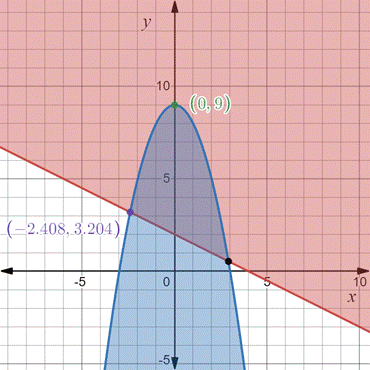
To calculate: The solution of the system of inequality and given he coordinates of any corner points.
The common region in the graph is the solution of the inequality and the corner points are
Given Information:
The system of inequality is,
Calculation:
Consider the given system of inequality,
The boundary point is included if the inequality containing
In the first inequality, the boundary is
And,
The intercepts of the equation are
To determine the half-plane to be shaded, use a test point not on the boundary, say
The statement is not true so the shade the half-plane where
In the second inequality, the boundary is
And,
The intercepts of the equation are
To determine the half-plane to be shaded, use a test point not on the boundary, say
The statement is true so the shade the half-plane where
Now, make the graph of the inequality.

Thus, the shaded part by both the inequality is the solution of the inequality.
And the corner points are defined as,
Hence, the corner points are
Chapter 7 Solutions
PRECALCULUS:GRAPHICAL,...-NASTA ED.
- i attached the question and the way i solved it, i believe i made an error, could you point it out for me because the correct answer is 3pi/2correct answer is D, please see both attached photosarrow_forwardQuestion 3 and 4arrow_forwardcould you explain this using stoke theoremi already circled the correct answerarrow_forward
- can you explain why the answer is 1/3arrow_forwardThe position of a particle that moves along the x-axis is defined by x = - 3t^2 + 12^t - 6 f, where t is in seconds. For the time interval t = 0 to t = 3 s, (1) plot the position, velocity, and acceleration as functions of time; (2) calculate the distance traveled; and (3) determine the displacement of the particleshow the graph and write the solution with a penarrow_forwardThe position of a particle that moves along the x-axis is defined by x = - 3t^2 + 12^t - 6 f, where t is in seconds. For the time interval t = 0 to t = 3 s, (1) plot the position, velocity, and acceleration as functions of time; (2) calculate the distance traveled; and (3) determine the displacement of the particleshow the graph and write the solution with a penarrow_forward
- The answer for number 1 is D Could you show me whyarrow_forwardThe path of a particle moving in a straight line is given by s = t^3 - 6t^2+ 9t + 4, where s is in ft and t in seconds. a. Finds and a when v = 0. b. Find s and v when a = 0.show the graph if needed and write the solution with a penarrow_forwardfind the roots it may help to know b =1arrow_forward
 Calculus: Early TranscendentalsCalculusISBN:9781285741550Author:James StewartPublisher:Cengage Learning
Calculus: Early TranscendentalsCalculusISBN:9781285741550Author:James StewartPublisher:Cengage Learning Thomas' Calculus (14th Edition)CalculusISBN:9780134438986Author:Joel R. Hass, Christopher E. Heil, Maurice D. WeirPublisher:PEARSON
Thomas' Calculus (14th Edition)CalculusISBN:9780134438986Author:Joel R. Hass, Christopher E. Heil, Maurice D. WeirPublisher:PEARSON Calculus: Early Transcendentals (3rd Edition)CalculusISBN:9780134763644Author:William L. Briggs, Lyle Cochran, Bernard Gillett, Eric SchulzPublisher:PEARSON
Calculus: Early Transcendentals (3rd Edition)CalculusISBN:9780134763644Author:William L. Briggs, Lyle Cochran, Bernard Gillett, Eric SchulzPublisher:PEARSON Calculus: Early TranscendentalsCalculusISBN:9781319050740Author:Jon Rogawski, Colin Adams, Robert FranzosaPublisher:W. H. Freeman
Calculus: Early TranscendentalsCalculusISBN:9781319050740Author:Jon Rogawski, Colin Adams, Robert FranzosaPublisher:W. H. Freeman
 Calculus: Early Transcendental FunctionsCalculusISBN:9781337552516Author:Ron Larson, Bruce H. EdwardsPublisher:Cengage Learning
Calculus: Early Transcendental FunctionsCalculusISBN:9781337552516Author:Ron Larson, Bruce H. EdwardsPublisher:Cengage Learning





